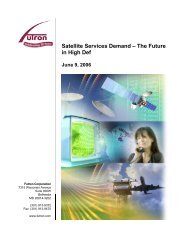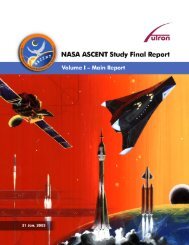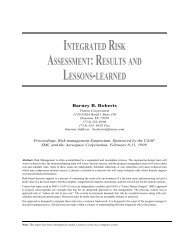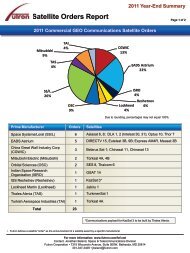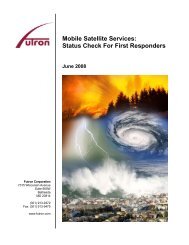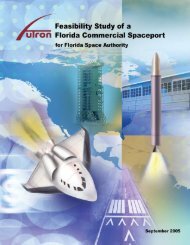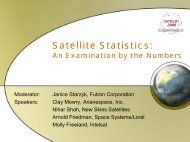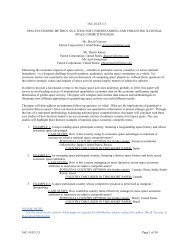Space Transportation Costs: Trends in Price Per Pound to Orbit ...
Space Transportation Costs: Trends in Price Per Pound to Orbit ...
Space Transportation Costs: Trends in Price Per Pound to Orbit ...
Create successful ePaper yourself
Turn your PDF publications into a flip-book with our unique Google optimized e-Paper software.
<strong>Space</strong> <strong>Transportation</strong> <strong>Costs</strong>:<br />
<strong>Trends</strong> <strong>in</strong> <strong>Price</strong> <strong>Per</strong> <strong>Pound</strong> <strong>to</strong> <strong>Orbit</strong><br />
1990-2000<br />
September 6, 2002<br />
Futron Corporation<br />
7315 Wiscons<strong>in</strong> Avenue<br />
Suite 900W<br />
Bethesda, Maryland 20814<br />
301-913-9372<br />
http://www.futron.com
Introduction<br />
The cost of space transportation has been noth<strong>in</strong>g less than an obsession for many people <strong>in</strong> the space<br />
<strong>in</strong>dustry. The perceived high cost of space transportation is generally viewed as one of the biggest<br />
obstacles, if not the biggest, <strong>to</strong> the growth of space commercialization and exploration. Civil space<br />
agencies, entrepreneurs, policy makers, legisla<strong>to</strong>rs, satellite opera<strong>to</strong>rs, and others have all focused on<br />
the cost of space transportation at one time or another. Even though each group has different reasons for<br />
be<strong>in</strong>g <strong>in</strong>terested <strong>in</strong> launch costs, they all share the same fixation – lower<strong>in</strong>g the cost of transport<strong>in</strong>g<br />
payloads <strong>in</strong><strong>to</strong> space.<br />
However, evaluat<strong>in</strong>g current and future launch vehicles on the basis of cost has been problematic. The<br />
costs of launch vehicles are usually compared by comput<strong>in</strong>g the cost <strong>to</strong> place one pound of payload <strong>in</strong><strong>to</strong><br />
orbit. This “cost per pound <strong>to</strong> orbit” metric has become widespread <strong>in</strong> the <strong>in</strong>dustry, and has been used <strong>to</strong><br />
establish goals for the cost performance of future launch vehicles. However, this seem<strong>in</strong>gly simple and<br />
widely used value is fraught with standardization issues that, if not fully unders<strong>to</strong>od, make it a far less<br />
useful <strong>to</strong>ol. This White Paper attempts <strong>to</strong> clarify the concept of price per pound <strong>to</strong> orbit and <strong>to</strong> identify<br />
some trends <strong>in</strong> the cost of space transportation us<strong>in</strong>g this metric.<br />
What Is <strong>Price</strong> <strong>Per</strong> <strong>Pound</strong> <strong>to</strong> <strong>Orbit</strong> and How Is It Calculated<br />
The simplest way <strong>to</strong> study the cost of space transportation is <strong>to</strong> compare the prices of launch vehicles.<br />
Unfortunately, this is generally a case of compar<strong>in</strong>g apples <strong>to</strong> oranges: all launch vehicles are not equal.<br />
A Pegasus XL, for example, costs far less than an Ariane 5, but is also a much smaller vehicle.<br />
Differences <strong>in</strong> vehicle size can mask more important cost differences caused by vehicle design, nation of<br />
manufacture, and other fac<strong>to</strong>rs.<br />
To compensate for this, the “price per pound <strong>to</strong> orbit” metric was developed <strong>to</strong> compare vehicles for their<br />
cost effectiveness, mostly <strong>in</strong> the comparison of vehicles <strong>in</strong> the design phase. <strong>Price</strong> per pound offers a<br />
simple way <strong>to</strong> normalize launch costs, permitt<strong>in</strong>g more mean<strong>in</strong>gful comparisons among vehicles of<br />
different capabilities. This metric has ga<strong>in</strong>ed wide acceptance, with almost every proposed new launch<br />
vehicle s<strong>in</strong>ce the <strong>Space</strong> Shuttle us<strong>in</strong>g some type of price-per-pound target.<br />
While price per pound is simple <strong>to</strong> compute arithmetically, it has many shortcom<strong>in</strong>gs. Determ<strong>in</strong><strong>in</strong>g the real<br />
price of a launch can be difficult, s<strong>in</strong>ce the terms of many launch contracts are not made public. In many<br />
cases only generic prices for launch vehicles are available, reduc<strong>in</strong>g the accuracy of the calculation. The<br />
choice of orbital altitude and <strong>in</strong>cl<strong>in</strong>ation affects the payload capacity of a vehicle, thus affect<strong>in</strong>g the<br />
calculation. These and other fac<strong>to</strong>rs, if not properly accounted for, reduce the effectiveness of the priceper-pound<br />
metric.<br />
Purpose of This White Paper<br />
As stated <strong>in</strong> the Executive Summary, the purpose of this White Paper is <strong>to</strong> clarify the concept of price per<br />
pound <strong>to</strong> orbit and <strong>to</strong> identify some trends <strong>in</strong> the cost of space transportation us<strong>in</strong>g this metric. This White<br />
Paper describes how various vehicles fare, generically, us<strong>in</strong>g the price per pound metric, and it describes<br />
the trends <strong>in</strong> the metric dur<strong>in</strong>g the 1990s for both commercial non-geosynchronous orbit (NGSO) – which<br />
<strong>in</strong>cludes low Earth orbit (LEO), medium Earth orbit, and highly elliptical orbits – and geosynchronous orbit<br />
(GSO) launches.<br />
The analyses <strong>in</strong> this White Paper rely on a database of launch vehicle prices that Futron has ma<strong>in</strong>ta<strong>in</strong>ed<br />
for almost a decade. The database is populated with publicly available <strong>in</strong>formation on launch prices and,<br />
every year, Futron performs an analysis <strong>to</strong> update the prices of all active launch vehicles <strong>in</strong> the database.<br />
This system worked well throughout the 1990s because there was sufficient publicly available <strong>in</strong>formation<br />
on launch prices that Futron could estimate price ranges with confidence.<br />
S<strong>in</strong>ce the year 2000, the launch vehicle <strong>in</strong>dustry has become extremely competitive. Public sources on<br />
launch vehicle prices have all but dried up. Executives at Arianespace and Boe<strong>in</strong>g Launch Services have<br />
been quoted as say<strong>in</strong>g prices have dropped by 20-30% recently. Because of this uncerta<strong>in</strong>ty <strong>in</strong> estimat<strong>in</strong>g<br />
current prices of launch vehicles, Futron has restricted the analysis <strong>in</strong> this White Paper <strong>to</strong> the time period<br />
1990-2000.<br />
© Futron Corporation 2002 1
Generic <strong>Price</strong> <strong>Per</strong> <strong>Pound</strong> Calculation<br />
Although the price-per-pound metric appears straightforward, there are a number of methods of comput<strong>in</strong>g<br />
it. One approach is <strong>to</strong> simply divide the estimated cost of a launch vehicle by its payload capacity. This<br />
approach permits a basic comparison of launch prices among various vehicles at a given po<strong>in</strong>t <strong>in</strong> time.<br />
<strong>Price</strong>-per-pound figures for a representative sample of commercial launch vehicles most commonly <strong>in</strong> use <strong>in</strong><br />
the 1990s, as well as the <strong>Space</strong> Shuttle, are presented <strong>in</strong> Tables 1 through 3. The vehicles are divided <strong>in</strong><strong>to</strong><br />
the four mass classes def<strong>in</strong>ed by the FAA Office of Commercial <strong>Space</strong> <strong>Transportation</strong>: small, medium,<br />
<strong>in</strong>termediate, and heavy, although for this discussion medium and <strong>in</strong>termediate vehicles will be grouped<br />
<strong>to</strong>gether. Separate price-per-pound figures are calculated for each vehicle’s LEO and, where relevant, GTO<br />
(geosynchronous transfer orbit) capacity. (GTO is used here because most launch vehicles place GSObound<br />
payloads <strong>in</strong> an <strong>in</strong>termediate transfer orbit, from which the spacecraft maneuvers <strong>in</strong><strong>to</strong> GSO.) All prices<br />
are given <strong>in</strong> year 2000 dollars based on the latest price <strong>in</strong>formation provided dur<strong>in</strong>g the decade, and do not<br />
<strong>in</strong>clude the costs of apogee kick mo<strong>to</strong>rs or other payload <strong>in</strong>jection means.<br />
Table 1: Small Launch Vehicles (5,000 lbs. or less <strong>to</strong> LEO)<br />
Vehicle name Athena 2 Cosmos Pegasus XL Rockot Shtil START Taurus<br />
Country/Region of orig<strong>in</strong> USA Russia USA Russia Russia Russia USA<br />
LEO capacity lb (kg) 4,520 (2,065) 3,300 (1,500) 976 (443) 4,075 (1,850) 947 (430) 1,392 (632) 3,036 (1,380)<br />
Reference LEO altitude<br />
mi (km)<br />
115 (185) 249 (400) 115 (185) 186 (300) 124 (200) 124 (200) 115 (185)<br />
GTO capacity lb (kg) 1,301 (590) 0 0 0 0 0 988 (448)<br />
Reference site and<br />
<strong>in</strong>cl<strong>in</strong>ation<br />
CCAFS<br />
28.5 deg.<br />
Plesetsk<br />
62.7 deg.<br />
CCAFS<br />
28.5 deg.<br />
Plesetsk<br />
62.7 deg.<br />
Barents Sea<br />
77-88 deg.<br />
Svobodny<br />
51.8 deg.<br />
CCAFS<br />
28.5 deg.<br />
Estimated launch price<br />
(2000 US$)<br />
$24,000,000 $13,000,000 $13,500,000 $13,500,000 $200,000* $7,500,000 $19,000,000<br />
Estimated LEO payload<br />
cost per lb (kg)<br />
$5,310 ($11,622) $3,939 ($8,667) $13,832 ($30,474) $3,313 ($7,297) $211 ($465) $5,388 ($11,687) $6,258 ($13,768)<br />
Estimated GTO payload<br />
cost per lb (kg)<br />
$18,448 ($40,678) N/A N/A N/A N/A N/A $19,234 ($42,411)<br />
* Shtil launch costs partially subsidized by the Russian Navy as part of missile launch exercises<br />
Table 2: Medium (5,001-12,000 lbs. <strong>to</strong> LEO) and Intermediate (12,001-25,000 lbs. <strong>to</strong> LEO) Launch Vehicles<br />
Vehicle name Ariane 44L Atlas 2AS Delta 2 (7920/5) Dnepr Long March 2C Long March 2E Soyuz<br />
Country/Region of orig<strong>in</strong> Europe USA USA Russia Ch<strong>in</strong>a Ch<strong>in</strong>a Russia<br />
LEO capacity lb (kg) 22,467 (10,200) 18,982 (8,618) 11,330 (5,144) 9,692 (4,400) 7,048 (3,200) 20,264 (9,200) 15,418 (7,000)<br />
Reference LEO altitude<br />
mi (km)<br />
124 (200) 115 (185) 115 (185) 124 (200) 124 (200) 124 (200) 124 (200)<br />
GTO capacity lb (kg) 10,562 (4,790) 8,200 (3,719) 3,969 (1,800) 0 2,205 (1,000) 7,431 (3,370) 2,977 (1,350)<br />
Reference site and<br />
<strong>in</strong>cl<strong>in</strong>ation<br />
Estimated launch price<br />
(2000 US$)<br />
Estimated LEO payload<br />
cost per lb (kg)<br />
Estimated GTO payload<br />
cost per lb (kg)<br />
Kourou<br />
5.2 deg.<br />
CCAFS<br />
28.5 deg.<br />
CCAFS<br />
28.5 deg.<br />
Baikonur<br />
46.1 deg.<br />
Taiyuan<br />
37.8 deg.<br />
Taiyuan<br />
37.8 deg.<br />
Baikonur<br />
51.8 deg.<br />
$112,500,000 $97,500,000 $55,000,000 $15,000,000 $22,500,000 $50,000,000 $37,500,000<br />
$5,007 ($11,029) $5,136 ($11,314) $4,854 ($10,692) $1,548 ($3,409) $3,192 ($7,031) $2,467 ($5,435) $2,432 ($5,357)<br />
$10,651 ($23,486) $11,890 ($26,217) $13,857 ($30,556) N/A $10,204 ($22,500) $6,729 ($14,837) $12,598 ($27,778)<br />
© Futron Corporation 2002 2
Table 3: Heavy Launch Vehicles (more than 25,000 lbs. <strong>to</strong> LEO)<br />
Vehicle name Ariane 5G Long March 3B Pro<strong>to</strong>n <strong>Space</strong> Shuttle Zenit 2 Zenit 3SL<br />
Country/Region of orig<strong>in</strong> Europe Ch<strong>in</strong>a Russia USA Ukra<strong>in</strong>e Mult<strong>in</strong>ational<br />
LEO capacity lb (kg) 39,648 (18,000) 29,956 (13,600) 43,524 (19,760) 63,443 (28,803) 30,264 (13,740) 34,969 (15,876)<br />
Reference LEO altitude<br />
km (mi)<br />
342 (550) 124 (200) 124 (200) 127 (204) 124 (200) 124 (200)<br />
GTO capacity lb (kg) 14,994 (6,800) 11,466 (5,200) 10,209 (4,630) 13,010 (5,900) 0 11,576 (5,250)<br />
Reference site and<br />
<strong>in</strong>cl<strong>in</strong>ation<br />
Estimated launch price<br />
(2000 US$)<br />
Estimated LEO payload<br />
cost per lb (kg)<br />
Estimated GTO payload<br />
cost per lb (kg)<br />
Kourou<br />
5.2 deg.<br />
Xichang<br />
28.5 deg.<br />
Baikonur<br />
51.6 deg.<br />
KSC<br />
28.5 deg.<br />
Baikonur<br />
51.4 deg.<br />
Odyssey Launch<br />
Platform<br />
0 deg.<br />
$165,000,000 $60,000,000 $85,000,000 $300,000,000 $42,500,000 $85,000,000<br />
$4,162 ($9,167) $2,003 ($4,412) $1,953 ($4,302) $4,729 ($10,416) $1,404 ($3,093) $2,431 ($5,354)<br />
$11,004 ($24,265) $5,233 ($11,538) $8,326 ($18,359) $23,060 ($50,847) N/A $7,343 ($16,190)<br />
Unlike the other vehicles listed <strong>in</strong> Tables 1-3, the <strong>Space</strong> Shuttle is not available commercially and thus does<br />
not have a launch price, per se, associated with it. Instead, the estimated cost (<strong>to</strong> NASA) <strong>to</strong> fly one shuttle<br />
mission is listed <strong>in</strong> Table 3. There are several ways <strong>to</strong> compute the cost of a shuttle mission, rang<strong>in</strong>g from<br />
divid<strong>in</strong>g the <strong>to</strong>tal NASA budget for the shuttle by the number of launches each year <strong>to</strong> estimat<strong>in</strong>g the<br />
marg<strong>in</strong>al cost of one additional shuttle flight. The former method can produce per-launch costs of over $500<br />
million, while the latter can lower the cost below $100 million. NASA’s <strong>Space</strong> <strong>Transportation</strong> Architecture<br />
Study <strong>in</strong> the late 1990s estimated a shuttle launch cost of $300 million, based on an annual budget of $2.4<br />
billion and eight flights a year, a rate NASA approached or achieved for most of the 1990s. We adopt the<br />
$300 million cost figure for this analysis, although we note that <strong>in</strong> the last few years the shuttle flight rate has<br />
dropped significantly without an appreciable decrease <strong>in</strong> the shuttle program budget, which would result <strong>in</strong> a<br />
sharp <strong>in</strong>crease <strong>in</strong> per-launch costs.<br />
The price-per-pound figures <strong>in</strong> Tables 1 through 3 span a wide range. There is a general trend of lower<br />
prices per pound for larger launch vehicles due <strong>to</strong> the economies of scale that a larger vehicle provides. The<br />
data also show that non-Western (Ch<strong>in</strong>ese, Russian, and Ukra<strong>in</strong>ian) vehicles tend <strong>to</strong> have lower prices than<br />
their Western (American and European) counterparts, primarily because of lower labor and <strong>in</strong>frastructure<br />
costs. Table 4 shows that these differences <strong>in</strong> average price per pound can be significant.<br />
Table 4: Average <strong>Price</strong> <strong>Per</strong> <strong>Pound</strong> for Western and Non-Western Launch Vehicles<br />
Vehicle Class LEO GTO<br />
Western Non-Western* Western Non-Western*<br />
Small $8,445 $3,208 $18,841 N/A<br />
Medium/Intermediate $4,994 $2,407 $12,133 $9,843<br />
Heavy $4,440 $1,946 $17,032 $6,967<br />
* The Zenit 3SL is considered a non-Western launch vehicle because of its Ukra<strong>in</strong>ian and Russian heritage.<br />
While this approach is simple, it has a key disadvantage: it treats launch vehicles as commodity items with a<br />
fixed price and capacity. In reality this is not the case. Negotiations for launch vehicles can result <strong>in</strong> widely<br />
vary<strong>in</strong>g prices, depend<strong>in</strong>g on cus<strong>to</strong>mer requirements, the exist<strong>in</strong>g supply of and demand for launch<br />
services, and any special provisions like bulk buys of launch vehicles or the exchange of equity or services<br />
for launch services. In addition, each launch vehicle is used for one time only and can be uniquely tailored <strong>to</strong><br />
some degree <strong>to</strong> meet the needs of each payload.<br />
© Futron Corporation 2002 3
Specific <strong>Price</strong> <strong>Per</strong> <strong>Pound</strong> Calculation<br />
A more robust approach is <strong>to</strong> compute the price per pound of each launch <strong>in</strong>dividually. This <strong>in</strong>creases the<br />
fidelity of the data and also provides a clearer view of pric<strong>in</strong>g trends over time. The pric<strong>in</strong>g <strong>in</strong>formation used<br />
<strong>in</strong> this study comes from Futron’s database of launch vehicle prices. Wherever possible, the specific price<br />
for each launch is used; otherwise, the average price for that launch vehicle is used <strong>in</strong>stead. All prices are<br />
normalized <strong>to</strong> constant year 2000 dollars <strong>to</strong> permit mean<strong>in</strong>gful comparisons from year <strong>to</strong> year. For each<br />
launch the <strong>to</strong>tal mass of the payload, rather than the rated capacity of the vehicle, is used <strong>to</strong> compute the<br />
price per pound. Us<strong>in</strong>g payload mass <strong>in</strong>stead of capacity makes only a modest difference <strong>in</strong> the price-perpound<br />
results for GSO launches, as the mass of the payloads averaged 80-90% of the capacity of the<br />
vehicles (for some launches the payload mass exceeds the capacity of the vehicle – <strong>in</strong> those cases vehicles<br />
use reserve propellant designed <strong>to</strong> guarantee proper orbital <strong>in</strong>sertion, trad<strong>in</strong>g away some accuracy for<br />
<strong>in</strong>creased performance). For launches <strong>in</strong><strong>to</strong> NGSO the choice <strong>in</strong> approach does make a significant difference<br />
<strong>in</strong> the results, as noted later <strong>in</strong> this White Paper.<br />
For this analysis we treat the GSO and NGSO launch markets separately. Other than the Delta 2, there is<br />
little overlap between these markets <strong>in</strong> the launch vehicles used. The technical requirements for reach<strong>in</strong>g<br />
these orbits are also very different, affect<strong>in</strong>g the payload capacity and thus price per pound. While the GSO<br />
market has a s<strong>in</strong>gle, well-def<strong>in</strong>ed orbit, the NGSO market encompasses a wide array of orbital altitudes and<br />
<strong>in</strong>cl<strong>in</strong>ations. For this analysis, we will treat these as a group despite these differences, not<strong>in</strong>g that most of<br />
these payloads are launched <strong>in</strong><strong>to</strong> low-Earth orbits several hundred kilometers high <strong>in</strong> non-polar <strong>in</strong>cl<strong>in</strong>ations.<br />
The results of this analysis are discussed <strong>in</strong> the follow<strong>in</strong>g sections.<br />
GSO Experience<br />
The cost of launch<strong>in</strong>g commercial payloads <strong>in</strong><strong>to</strong> GSO, as measured us<strong>in</strong>g the price-per-pound metric,<br />
dropped significantly <strong>in</strong> the 1990s. The average price per pound fell from $18,158 <strong>in</strong> 1990 <strong>to</strong> $11,729 <strong>in</strong><br />
2000 (measured us<strong>in</strong>g constant year 2000 dollars), a drop of 35% dur<strong>in</strong>g the decade. As illustrated <strong>in</strong> Figure<br />
1, however, prices did not decrease steadily throughout the decade. Instead, there was a sharp decrease <strong>in</strong><br />
launch prices <strong>in</strong> the first half of the decade, with prices then hold<strong>in</strong>g constant around $12,000 per pound<br />
through the latter half of the 1990s.<br />
$30,000<br />
Figure 1: Estimated Launch <strong>Price</strong> <strong>Per</strong> <strong>Pound</strong> for Commercial GSO Payloads (constant 2000$)<br />
$25,000<br />
Dollars per pound<br />
$20,000<br />
$15,000<br />
$10,000<br />
1990 average:<br />
$18,158/lb.<br />
2000 average:<br />
$11,729/lb.<br />
$5,000<br />
$0<br />
1988 1990 1992 1994 1996 1998 2000 2002<br />
Year of Launch<br />
This pric<strong>in</strong>g trend can be expla<strong>in</strong>ed <strong>in</strong> large part by <strong>in</strong>creased competition <strong>in</strong> the commercial launch <strong>in</strong>dustry,<br />
notably the <strong>in</strong>troduction of the Ch<strong>in</strong>ese Long March and the Russian Pro<strong>to</strong>n launch vehicles <strong>to</strong> the market <strong>in</strong><br />
the early and mid 1990s, respectively. These vehicles were aggressively priced compared <strong>to</strong> their Western<br />
counterparts, creat<strong>in</strong>g downward pressure on prices for the overall launch market. While three families of<br />
© Futron Corporation 2002 4
Western launch vehicles – Ariane, Atlas, and Delta – account for 81% of the commercial GSO launches <strong>in</strong><br />
this time frame, the average price per pound for these launches <strong>in</strong> a given year was as much as $1,000<br />
higher than the average for all vehicles. By the end of the decade, however, Western vehicles had reached<br />
rough parity on a price-per-pound basis with their non-Western counterparts; this can be seen <strong>in</strong> Figure 1 by<br />
notic<strong>in</strong>g the reduced scatter <strong>in</strong> the data po<strong>in</strong>ts <strong>in</strong> the late 1990s versus the early 1990s. The departure of<br />
Ch<strong>in</strong>ese boosters from the commercial GSO market <strong>in</strong> the late 1990s because of reliability and export<br />
control issues likely also played a role <strong>in</strong> stabiliz<strong>in</strong>g prices by remov<strong>in</strong>g one of the sources of downward<br />
pressure on prices.<br />
NGSO Experience<br />
There is considerably less data for commercial NGSO launch pric<strong>in</strong>g, simply because there have been far<br />
fewer commercial launches <strong>to</strong> NGSO than <strong>to</strong> GSO: there were 64 commercial NGSO launches <strong>in</strong> the<br />
1990-2000 period, compared <strong>to</strong> nearly 200 commercial GSO launches. The price-per-pound data for<br />
those commercial NGSO launches, normalized <strong>to</strong> constant year 2000 dollars, are plotted <strong>in</strong> Figure 2.<br />
$60,000<br />
Figure 2: Estimated Launch <strong>Price</strong> <strong>Per</strong> <strong>Pound</strong> for Commercial NGSO Payloads (constant 2000$)<br />
$50,000<br />
Dollars per pound<br />
$40,000<br />
$30,000<br />
$20,000<br />
$10,000<br />
$0<br />
1992 1994 1996 1998 2000 2002<br />
Year of Launch<br />
Unlike the commercial GSO data, there are no clear trends <strong>in</strong> the price per pound of commercial NGSO<br />
launches. Most launches s<strong>in</strong>ce 1995 cluster near $10,000 per pound, although there are some significantly<br />
higher outliers. These results can be expla<strong>in</strong>ed <strong>in</strong> large part by the fact that commercial NGSO payloads<br />
have generally utilized a far smaller portion of the vehicle’s stated capacity than GSO launches. While GSO<br />
payloads used 80-90% of a vehicle’s capacity on average dur<strong>in</strong>g the 1990-2000 period, NGSO payloads<br />
have used less than half of a vehicle’s stated capacity dur<strong>in</strong>g this time, even though many NGSO launches<br />
are multi-manifested with several spacecraft on each launch vehicle. Technical limitations of putt<strong>in</strong>g<br />
spacecraft <strong>in</strong> multiple orbital planes on one launch, as well as a desire <strong>to</strong> limit the exposure of a satellite<br />
constellation <strong>to</strong> a launch failure, put limits on multi-manifested launches that fall short of the vehicle’s<br />
payload capacity. Many of the data po<strong>in</strong>ts <strong>in</strong> Figure 2 with values greater than $20,000 a pound can be<br />
expla<strong>in</strong>ed by launches that use a quarter or less of the capacity of the vehicles.<br />
© Futron Corporation 2002 5
Conclusions<br />
The price per pound of launch vehicles can be computed <strong>in</strong> two ways: a generic estimate us<strong>in</strong>g estimated<br />
launch vehicle costs and published payload capacities, and a more specific computation for each launch<br />
event us<strong>in</strong>g the cost of the vehicle for that launch and the mass of its payload. The generic metric offers a<br />
qualitative measure of launch <strong>in</strong>dustry costs, with lower prices per pound for larger as well as non-<br />
Western vehicles. The specific metric avoids a number of disadvantages of the generic metric and<br />
permits a more detailed, quantitative study of launch costs over the period.<br />
The commercial GSO launch market has shown, on a specific price-per-pound basis, significant reductions<br />
<strong>in</strong> launch costs between 1990 and 2000. This can be attributed <strong>in</strong> large part <strong>to</strong> <strong>in</strong>creased competition,<br />
particularly the <strong>in</strong>troduction <strong>in</strong> the first half of the decade of lower-priced Ch<strong>in</strong>ese and Russian launch<br />
vehicles. The overall commercial launch market adjusted by lower<strong>in</strong>g prices, stabiliz<strong>in</strong>g around $12,000 per<br />
pound <strong>in</strong> the latter half of the 1990s, nearly one-third less than launch costs at the beg<strong>in</strong>n<strong>in</strong>g of the decade.<br />
While this decrease is significant, it has failed <strong>to</strong> stimulate <strong>in</strong>creased commercial activity. S<strong>in</strong>ce the late<br />
1990s demand for commercial launches has dropped dramatically, from over 35 launches a year <strong>in</strong> the late<br />
1990s <strong>to</strong> only 16 <strong>in</strong> 2001. Most <strong>in</strong>dustry forecasts show that commercial launch activity is unlikely <strong>to</strong> return<br />
<strong>to</strong> the peak levels of the late 1990s for the next ten years, despite the reduction <strong>in</strong> launch costs. This<br />
demonstrates the price <strong>in</strong>elasticity of the current launch market.<br />
Regard<strong>in</strong>g NGSO launch prices, there is no clear trend <strong>in</strong> the price-per-pound metric, other than a cluster<strong>in</strong>g<br />
around $10,000 per pound <strong>in</strong> the late 1990s. While this is lower than GSO launches, it is not as low as one<br />
might expect, because NGSO payloads have generally used a lower fraction of a vehicle’s capacity than<br />
GSO payloads.<br />
Although any decrease <strong>in</strong> the cost of space access is hearten<strong>in</strong>g, the decreases <strong>in</strong> price per pound seen <strong>in</strong><br />
the last decade, as significant as they may be, appear <strong>to</strong> fall well short of what is needed <strong>to</strong> trigger major<br />
<strong>in</strong>creases <strong>in</strong> commercial space activity. Far deeper cuts <strong>in</strong> the price per pound <strong>to</strong> orbit, such as the<br />
$1,000/pound goal of NASA’s <strong>Space</strong> Launch Initiative, may be necessary <strong>to</strong> promote growth of the<br />
commercial space sec<strong>to</strong>r.<br />
© Futron Corporation 2002 6
Futron Overview<br />
Futron applies analytically rigorous decision-support methods <strong>to</strong> transform<br />
data <strong>in</strong><strong>to</strong> <strong>in</strong>formation. We collaborate closely with clients <strong>to</strong> relate decisions<br />
<strong>to</strong> future outcomes and measures of value. Our aerospace consult<strong>in</strong>g<br />
services <strong>in</strong>clude market and <strong>in</strong>dustry analyses, safety and risk management,<br />
remote sens<strong>in</strong>g, and communications and <strong>in</strong>formation management.<br />
Futron’s vision and commitment <strong>to</strong> <strong>in</strong>novation, quality and excellence results<br />
<strong>in</strong> a higher perform<strong>in</strong>g future for clients.<br />
Summary of Capabilities<br />
Futron’s headquarters <strong>in</strong><br />
Bethesda, Maryland<br />
Futron’s <strong>Space</strong> and Telecommunications Division is the <strong>in</strong>dustry leader <strong>in</strong> research<strong>in</strong>g, analyz<strong>in</strong>g, and<br />
forecast<strong>in</strong>g space and telecommunications markets and programs. Futron offers our commercial and<br />
government clients a suite of proprietary, lead<strong>in</strong>g-edge analytic methodologies. Our world-class team of<br />
market and policy analysts, economists, and eng<strong>in</strong>eers br<strong>in</strong>g unparalleled skills and expertise <strong>to</strong> each<br />
account.<br />
We have surveyed hundreds of aerospace firms <strong>to</strong> develop a unique revenue, employment, and<br />
productivity profile of the <strong>in</strong>dustry.<br />
We have developed country-by-country models of demand for telecommunication services that<br />
aggregate a global forecast up from the <strong>in</strong>dividual household PC or bus<strong>in</strong>ess network; these models<br />
have accurately predicted future launch levels and bus<strong>in</strong>ess changes <strong>in</strong> the satellite <strong>in</strong>dustry.<br />
Futron helps clients w<strong>in</strong> competitions, analyze competi<strong>to</strong>rs, estimate costs and prices, and track<br />
opportunities.<br />
Futron also performs cost estimates and economic analyses. Futron generates bot<strong>to</strong>ms up,<br />
parametric, and analogous cost estimates for commercial satellite and launch vehicle programs.<br />
Futron provides a subscription-based service provid<strong>in</strong>g <strong>in</strong>formation on every FCC satellite application<br />
filed s<strong>in</strong>ce 1990. Futron’s FCCFil<strong>in</strong>gs.com is the only source for competitive <strong>in</strong>telligence and bus<strong>in</strong>ess<br />
data conta<strong>in</strong>ed <strong>in</strong> FCC satellite licens<strong>in</strong>g documents.<br />
For <strong>in</strong>formation about this or other Futron reports, or <strong>to</strong> <strong>in</strong>quire about Futron’s consult<strong>in</strong>g services, contact<br />
Eileen McGowan at 301-347-3431 or emcgowan@futron.com.<br />
© Futron Corporation 2002 7



